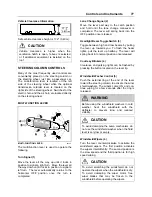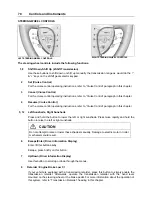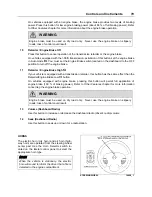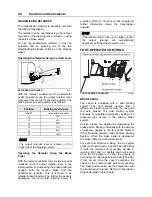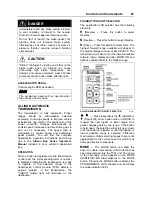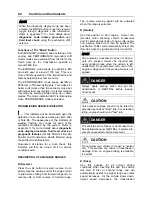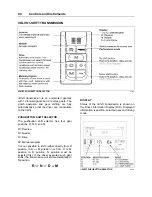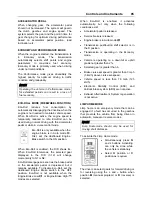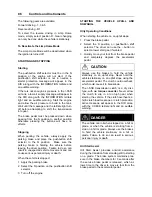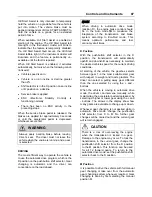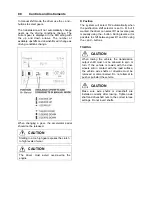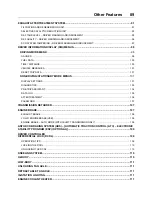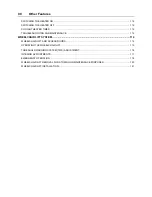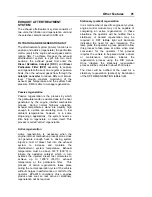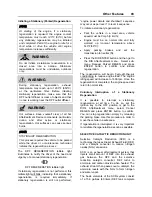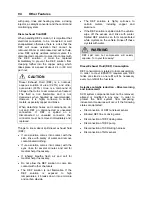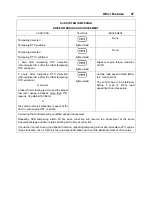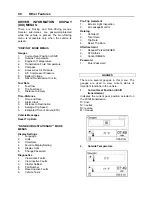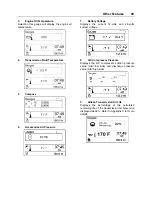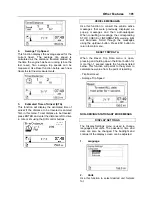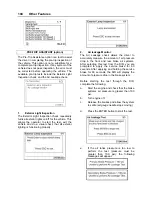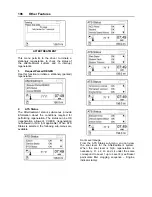
Other
Features
91
EXHAUST AFTERTREATMENT
SYSTEM
The exhaust aftertreatment system consists of
two units, the filtration and regeneration unit and
the selective catalytic reduction SCR unit.
FILTRATION AND REGENERATION UNIT
The aftertreatment system primary function is to
capture and oxidize (regenerate) the particulate
matter (soot) in the engine exhaust gases and to
reduce NOx. To achieve this goal, the exhaust
aftertreatment system is split into two main
sections: the exhaust gases first enter the
Diesel Oxidation Catalyst (DOC)
and
Diesel
Particulate Filter
(DPF)
assembly to capture
and regenerate the soot on a regular or passive
basis, then the exhaust gases flow through the
catalytic converter
to reduce NOx to minimum
level. Through constant monitoring of the
exhaust gas temperature and the system back
pressure, EMS is able to manage regeneration.
Passive regeneration
Passive regeneration is the process by which
the particulate matter is oxidized due to the heat
generated by the engine internal combustion
process. During normal highway operation,
exhaust temperatures alone are usually high
enough to oxidize accumulating soot. In low
ambient temperatures, however, or in some
stop-and-go applications, the system needs a
little help to regenerate, or clean itself. This
process is called “active” regeneration.
Active regeneration
Active regeneration is necessary when the
engine internal combustion process alone does
not generate enough heat. A dosing system
injects a mist of diesel fuel into the exhaust
system to increase and maintain the
aftertreatment system temperature. Exhaust
temperature must be above 572°F (300°C) to
initiate the oxidation catalyst, which in turn
oxidizes the injected diesel fuel molecules to
achieve up to 1200°F (650°C) exhaust
temperature at the particulate filter. This
process of active regeneration takes place
during the normal operation cycle of the vehicle
without charges in performance or control for the
operator. EPA2010 compliant Volvo engines
produce less soot, so less active or stationary
regeneration will be required.
Stationary (parked) regeneration
In a small number of specific engine duty cycles,
engine control module may not be capable of
completing an active regeneration. In these
situations, the operator will be notified that a
stationary or parked regeneration may be
required. A DPF telltale light will illuminate
indicating the need for user interaction. The
lamp gives the operator a grace period to allow
this process to take place at a time when most
convenient for the operator. This process
requires the vehicle to be parked while a driver
or maintenance technician initiates the
regeneration process using the DID menus.
Once initiated, the stationary regeneration
process will be complete in about 45 minutes.
The driver will be notified of the need for a
stationary regeneration (parked) by illumination
of the DPF REGENERATION telltale light.
Содержание X3-45 2011
Страница 1: ...COACH MANUFACTURER OPERATOR S MANUAL X3 45 COACH PA1581...
Страница 4: ......
Страница 6: ......
Страница 7: ...Safety Precautions 1 SAFE OPERATING PRACTICES 2 DEFENSIVE DRIVING PRACTICES 2 OTHER PRECAUTIONS 3...
Страница 10: ......
Страница 24: ......
Страница 128: ......
Страница 134: ......
Страница 166: ...Care and Maintenance 160 COMPONENTS IDENTIFICATION COMPONENTS REPRESENTATION MAY DIFFER SLIGHTLY FROM AN ACTUAL VEHICLE...
Страница 171: ...Technical Information 165 X3 45 OVERALL DIMENSIONS SIDE ELEVATION 18673...
Страница 172: ...Technical Information 166 X3 45 OVERALL DIMENSIONS TOP FRONT AND REAR VIEWS 18674...
Страница 182: ......
Страница 186: ......
Страница 206: ......

